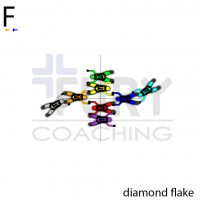8-way Basics: Building Between the Point and Tail
Thursday, September 12, 2019

Building between the Point and Tail is an engineering concept that should be familiar to experienced 4-way competitors and is happily the same in 8-way. If you maintain this angle you are moving from point to point the most efficient way possible.
This is a short series of articles that will help you break down and understand how 8-ways are built. While focusing on the formations in the competition pool, the tools shown here are highly transferable to general formation skydiving.
8-way Basics: Finding your slot
8-way Basics: Finding your clone
8-way Basics: Finding the centers
8-way Basics: Build the center first
8-way Basics: In-facing strategy
8-way Basics: Staged setups
8-way Basics: Round formations
8-way Basics: Fall rate
8-way Basics: Shared keying
8-way Basics: Line between point and tail
8-way Basics: Block inters
Imaginary Line
Imagine a line drawn through the center points of the Point and Tail of your 8-way team. As you progress to the next point a team wants to keep the Point and Tail on this line. The pair can move closer or further to each other along the line and they may individually rotate.
The rest of the team moves in a way that allows them to stay on this track. This generally produces the most efficient way to transition from one point to the next.
As the team gets comfortable with the idea, the team can learn to see this imaginary line very clearly before they make their next move. This allows them to set correct angles with confidence, and for the whole team to move exactly to the correct spot from point to point.
The Zipper Flake Deception
For example, we will look at a formation that has a less obvious line at first glance. The Zipper Flake has a natural line through the zipper grips that is easy to see and understand. When transitioning from something like a Diamond Flake it is tempting for the group to place this grip line through the grip line right down the middle. However, the real line of the zipper flake is through the Point and Tail.
If you compare the two options, you can see building it on the real centerline requires less movement.


This zipper builds on the grip line instead of the correct line. Notice how much the cyan or the green flyer move.


This is the correct line. Not as obvious to build, but faster for everyone.
Exceptions. Always Exceptions.
- The rule that rotation is faster than translation can supersede this one. This is unusual and barely important. You really can’t go wrong with the original plan.
- I break this rule on purpose occasionally. For new teams, the obvious down the grip-line build might be more movement, but they gain back the time because it is obvious and easy.
Seeing this line will help the team, especially the centers, anticipate the optimal builds from point to point. This, in turn, leads to efficiency, which makes your jump faster and your scores higher!
Tags: 8way



